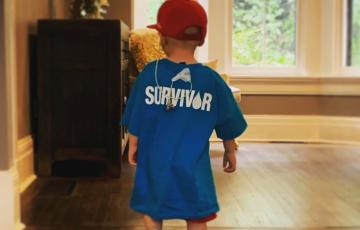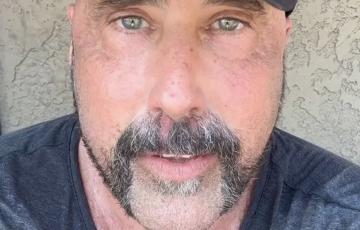Search Results

Madeline
I was diagnosed with acute myeloid leukemia (AML) in June of 2022. I was feeling fine and went for a routine physical where it was discovered that my white blood cell count was very low. This was the beginning of my nightmare. I was slotted to give my husband my kidney before I was diagnosed and had to quickly find another donor. We did and he got his transplant and is doing well. I was hospitalized for 8 weeks where I received very aggressive induction chemo that left me malnourished and on death’s doorstep.
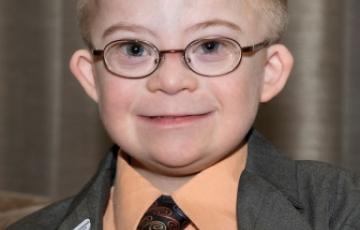
Liam
One of the Boston Bruin’s biggest fans, Liam Fitzgerald garnered national recognition as the “fist bump kid” and went on to raise almost $153,000 for The Leukemia & Lymphoma Society (LLS) to help fight blood cancers.

Nikki
I was 24 and otherwise healthy, hiking the Grand Canyon (literally) with friends, when my neck started to hurt and my arm started to swell. By the end of my vacation two days later, I was in so much pain that I could barely turn my head or lift my arm. I returned to Detroit and went straight from the airport to the ER, where, after hours of tests, I learned about a softball-sized tumor in my chest cavity, which was pressing on veins near my heart, causing blood clots in my shoulder, which resulted in the swelling and pain.
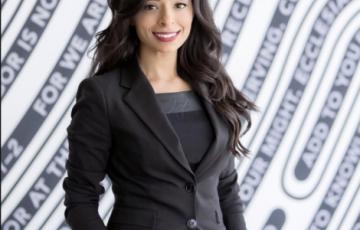
Joy
On December 29, 2011, I heard those numbing words “you have cancer.” I was 23 years old, about to turn 24 and my whole world came to a screeching halt. After months of feeling “off,” multiple visits to all kinds of doctors, repeat blood work, scans and biopsies, it was finally determined that I had non-Hodgkin’s lymphoma.
Debra
In October 2011, while at work, I fell after attempting to sit on a chair, and I went to the emergency for x-rays. As soon as the technician began the process, he entered the room to ask if I had scoliosis. I replied, "no" and he proceeded with the exam.

Kennedy
Kennedy was diagnosed with mono at age 12. Within a week she developed swelling and had a hard time breathing when laying down. Our pediatrician advised us to go to the children’s hospital where they did CT scans, MRIs and discovered a soft-sized mass pressing against her airway. There we got the news you never want to hear, our girl had lymphoma. Before that day, she was a normal child, playing volleyball, singing in the choir, being a kid.

Carol
Meet carol. hodgkin survivor. indiana. Carol was diagnosed with Hodgkin lymphoma in 2010. After being a stay-at-home mom, she went back to school to get her teaching degree and found out she had a grapefruit size tumor in her chest when she was one week away from finishing her student teaching. She put off finding a teaching job for a year while going through six months of chemotherapy. She was able to work as a learning specialist while going through her treatments as she had a very supportive principal.

Kate
"You have cancer" is one of the scariest things you might ever hear. When Kate was diagnosed with non-Hodgkin lymphoma (NHL), she initially thought about how she wasn't strong enough and how she wasn't ready to die. Then she calmed down and told herself she didn't really have a choice.
"You have to do this; you have to be strong."

Kendra
I first learned of The Leukemia & Lymphoma Society (LLS) when I participated in a Team in Training (TNT) event to walk a half marathon in San Francisco in October 2004. My friend in Michigan had lost her dad to lymphoma earlier that year, and she was training for the event from her home in Michigan. My training and participation were a way to support her during the loss of her dad. I never thought I could walk that far, and, through the support of the trainers and the motivation to support my friend, I had an awesome time completing that walk.
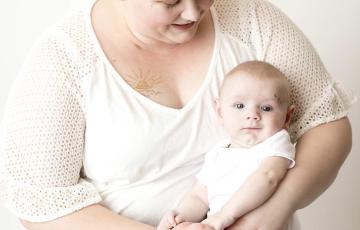
Caitlyn
My world started to turn upside down in January of 2019 after starting to exercise and trying to lose weight. At first, I thought I had pulled a muscle in my leg. The cramping continued to increase and turned into radiating bone pain. I went to get an x-ray to make sure nothing was broken. There were no broken bones or fractures, so they sent me on my way.

Scott
My experience with lymphoma began unexpectedly in August 2016. I began experiencing back pain with a large swollen band growing diagonally across my back. Thinking it was probably muscular, I went to see my physician who ordered an MRI. Cancer had never crossed my mind when he called me that same day and said I needed to be seen very soon by an oncologist. I was dumbfounded and left with no words. After scans, bloodwork, and a number of doctors collaborating on the findings, it was determined that I had stage 4B peripheral T-cell non-Hodgkin lymphoma (PTCL).
Options for Sperm Preservation
You may be able to take certain steps and precautions to preserve fertility before, during and after treatment.
Coping With Cancer
When someone is diagnosed with cancer, everyone in his or her family is affected. This holds especially true when a child has cancer. Different families have different ways of coping, but there are some sound strategies that anyone can employ. For useful tools and tips that may help, see the following pages:
ALL Subtypes
The subtypes of ALL are identified based on certain features of the leukemia cells. Determining the ALL subtype is an important factor in treatment planning. The doctor will discuss with you which drug combinations are indicated based on your child’s ALL subtype.
Leukemia cells can be classified by the unique set of proteins found on their surface. These unique sets of proteins are known as “immunophenotypes.” Based on immunophenotyping of the leukemia cell, the World Health Organization (WHO) classifies ALL into two main subtypes.
Side Effects
Cancer therapy for chronic myelomonocytic leukemia (CMML) can sometimes produce side effects. For most patients, treatment side effects are temporary and go away once therapy ends. For other patients, side effects can be more severe, sometimes requiring hospitalization. Some patients never have any side effects.
Before you undergo treatment, talk with your doctor about potential side effects. Drugs and other therapies can prevent or manage many side effects.
Disease Complications
In medicine, a complication is a medical problem that occurs during the course of a disease or after a procedure or treatment. Possible complications of ET include:
Disease Complications
In medicine, a complication is a medical problem that occurs during the course of a disease or after a procedure or treatment. Possible complications of PV include:
Vaccine Therapy
Vaccines designed to treat cancer don't prevent the disease in the same way that conventional vaccine therapy prevents conditions such as measles or polio. The therapeutic cancer vaccines are designed to treat an already-present cancer and reduce its potential to grow.
Researchers are working on vaccines that could prevent cancer from recurring. Currently, there are no licensed blood cancer vaccines. Vaccines for leukemia, lymphoma and myeloma are still in development and available only in clinical trials.
Skin and Nails
SkinSkin-related side effects from cancer treatment include:
- Dry skin
- Redness
- Itchiness
- Skin lesions
Tell your doctor about any changes to your skin. Your doctor can recommend or prescribe appropriate treatment, including topical solutions (creams, lotions or gels) to soothe your skin or relieve itching.
Tell you doctor immediately if you notice:
Special Considerations
Surgery. Patients with PV have increased risk for bleeding complications after surgery. Because your surgeon may not be aware of your increased risk for bleeding and blood clots, coordination between your surgeon and your hematologist-oncologist is very important. For elective surgeries, it is recommended that your platelet and red blood counts be in normal range before the surgery occurs.
Signs and Symptoms
Signs and symptoms are changes in the body that may indicate the presence of disease. A sign is a change that the doctor sees during an exam or in a laboratory test result. A symptom is a change that a patient can see and/or feel.
It is common for a child with ALL to feel a loss of well-being because of the lack of normal, healthy blood cells.
Symptoms of a low red blood cell count (anemia) include:
'Chemobrain'
Chemotherapy and radiation therapy can cause problems with cognitive (mental) functions, such as concentration, memory and the ability to multitask. Most chemotherapy patients experience these effects, sometimes referred to as “chemobrain” or brain fog, to some degree, although doctors are unable to predict who might be affected.
The cognitive effects of chemotherapy for some are long-lasting. A small percentage of patients have long-term effects known as "chemotherapy-induced cognitive impairment." The symptoms include a mental fogginess and effects on:

Ernest
During my summer internship at General Motors in Flint, Michigan, I suddenly started feeling extremely restless. Soon after a lump the side of a golf ball appeared on my neck and I got an extreme sore throat. A doctor told me I just had a sinus infection and gave me Theraflu.
